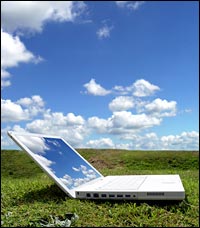Dear Umbra,
I am buying a new laptop, and I was wondering if all computers are the same energy-wise, or if some brands are better for the environment?
Aviva Horrow
Philadelphia, Pa.
Dearest Aviva,
You’re already off to a good start, as laptops consume far less energy than desktop machines — we’re talking over 50 percent less.

Thin is in.
Photo: iStockPhoto.
Computer manufacturers have three opportunities to earn their environmental stripes: during a machine’s manufacture, use, and disposal. From what I’ve read, the worst environmental legacy of computers will be toxic waste, rather than energy consumption. (Not to sneer at energy consumption issues, natch.) What we want to be able to start looking for in our computer choices is responsible manufacture and responsible end-of-life stewardship. We don’t quite seem to be there yet, but take heart: think about the time lag between onset of chemical agriculture and onset of the organics label.
I’ll start with the easiest category, which is energy consumption during use. The gummint’s Energy Star program includes computers. It’s not the most cutting-edge program, but it is pretty good. Once you buy a machine, you can conserve by turning it completely off when you are not using it. Be sure to also use whatever “energy saver” settings are available so that it sleeps when you pause for a while. Do not use the incorrectly named “screen savers,” and do not believe people who claim that restarting your computer uses more energy than leaving it on. It is not true.
Manufacture and disposal are a bit harder to suss. As previously discussed by yours truly, small electronic gizmos are built from useful but toxic materials. Lead solder, mercury switches, beryllium something-or-others, brominated flame retardants, PVC … manufacturers set out to make an effective, economical machine, and these are the resultant materials which, unfortunately, surround us in our homes. Remember, we asked for it.
The future of computer fabrication from an environmental standpoint includes designing machines that can be upgraded by part replacement rather than wholesale junking, can be easily taken apart at reclamation sites, and, of course, contain less-toxic materials when possible. We need to be sure that these toxics do not end up in landfills, but are instead reclaimed. When you are shopping, you could decide to purposefully support a manufacturer with an end-of-life takeback policy, which is also starting to adjust production techniques. I had a hard time finding an easy ranking of manufacturers on this front. The best I can do for you is my previous column on computer recycling, and a report from the Silicon Valley Toxics Coalition from a few years back. Better than nothing!
Remember, you are basically breaking new consumer ground here. When you make your choice, let the company know why you chose them, and send letters to a few other manufacturers to let them know why they lost out. Every letter makes a small dent in everyone’s indifference to this issue.
Motherboardly,
Umbra


